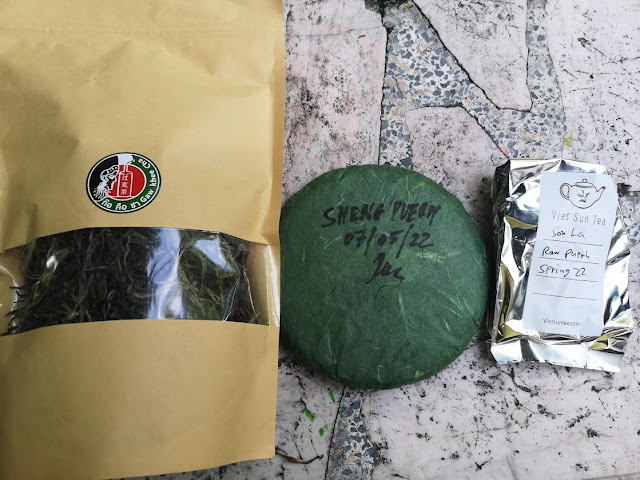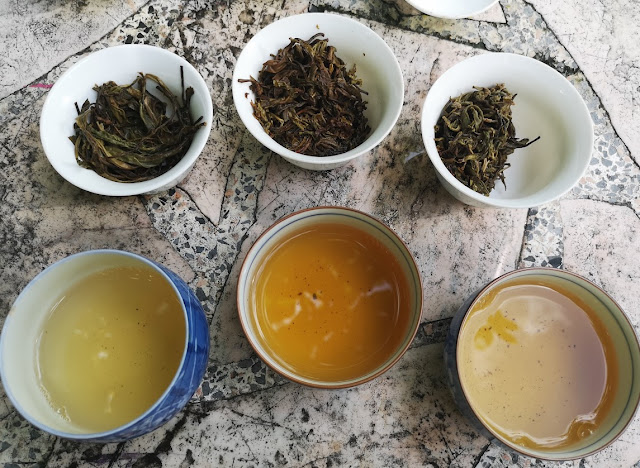First published in TChing here
Recently I've been trying pleasant wild origin material sheng versions from the Viet Sun vendor, passed on by an American contact who founded that business, Steve Shafer. Those were distinctive and pleasant, and Vietnamese black teas can also be exceptional. Or any types, really, but the rolled oolongs seem to clearly be a Taiwanese style input, and sheng are mostly varying copies of Yunnan style pu'er (with two of those three a little different in style). As with Vietnamese green teas the black tea versions can vary a lot, some quite unique and distinctive. I first visited Vietnam and tried versions from there before my blog started, but an early post was about picking up interesting versions in a second trip to Hanoi awhile back.
The Viet Sun range seems to mostly relate to wild origin oriented material; let's start with if these are that:
A really pretty (all qualities) black tea from Hoàng Su Phì, Hà Giang.
This tea was produced from ancient trees growing at around 1600m in elevation.
The first thing I notice when drinking this tea is the thick mouthfeel. The fragrance is quite sweet and builds after a few cups. The sweetness is also complex like caramel and forest flower honey...
The qi builds slowly. It creeps up throughout the session. I usually feel it getting strong by about the 5th cup.
Season: Spring 2022
Picking Standard: 1 bud, 2 leaves
Region: Hoàng Su Phì, Hà Giang
Elevation: 1600m
It looks like a Dian Hong style tea, like a related version made from Assamica plants. At $21 / 100 grams the pricing seems value oriented, if this is as good as it looks. I take the "ancient trees" part with a grain of salt, but it probably is from mixed age, wild origin context plants, which is generally positive for a few reasons. Final product aspects can be nice from those, and it's unlikely that a producer would take chemical fertilizer and pesticide out into a forest to treat local plants already growing there.
Lai Châu Secret Forest Black ($26 / 100 grams)
This is another really interesting tea from Phong Thổ, Lai Châu.
Producing this tea requires a long walk into the ancient tree gardens at over 2200m in elevation. Picking the leaves to make this tea is also an arduous task as some of the trees here grow over 20m tall!
The tea trees used to make this tea are a non-Sinensis, Camellia varietal. Research on exactly which varietal they are is still pending!
This tea is more restrained initially in fragrance and flavor compared to Lai Châu Forest Black as more of the fragrance is hidden in the liquor.
This tea brews up with a thick pale copper colored soup. The flavor is really complex. You'll notice a woody- tree root caramel flavor that starts building in the throat after a few cups. Sweet almost chewy huigan lasts well after the session has finished. I like brewing it at 85-90 degrees for shorter and then longer steeps.
This is a strong tea with an intense qi. It puts me in a tea-drunken stupor every time I drink it. Not for the faint-hearted!
Season: Spring 2022
Picking Standard: 2-3 leaves and some buds
Region: Phong Thổ, Lai Châu
Elevation: 2200m
Of course the qi input won't be clear at all for trying these together, one trade-off to that approach. I don't tend to notice that very much anyway, mostly only related to when it stands out in sheng pu'er versions. The part about the plant type being unique and unidentified is interesting; that comes up a good bit here in Thailand too. Genetics of plants can drift over time, and there are versions beyond standard variety Sinensis and Assamica around, I guess related to Taliensis and whatever else. It's not unusual for tea from such plant types to express unique flavors.
Review:
Hoang Su Phi: A bit light and twisted in style, similar in appearance to Dian Hong, a Yunnan black tea style. The brewed liquid color is rich but slightly less red than the other, probably related to a backed-off oxidation level. The flavor is subtle still; this will need another round to get started. What shows up so far is really nice, in that roasted yam or sweet potato range common to Dian Hong, maybe with a bit of cinnamon beyond that. Depth of this is good, richness and complexity.
Lai Chau: This looks darker, more conventionally fully oxidized, as most black tea outside of Yunnan styles tend to be prepared. It's more intense, which is just about starting faster, at this point. An interesting savory range stands out, like sun-dried tomato. It will also be easier to extend that to a flavor list next time.
Overall effect in this is positive already, even for it being a bit light still, the rich feel, sweetness, and overall complexity. It may include a touch of menthol edge, or mintiness; that can be a really interesting and positive inclusion in some tea versions. For black tea I mainly remember it coming up for Ruby / Red Jade / #18, a Taiwanese cultivar, and a wild origin version from Laos, which may be closer to this context. It was amazing in that version, more like wintergreen mint than menthol, which to me worked much better.
Hoang Su Phi second infusion: these are both beautiful teas, the look of the leaves and brewed liquid. The scent of just the wetted leaves is amazing, rich and deep for this version, with a couple of distinctive aspect notes in the other. Depth of the experience stands out in this tea, more so than the intense, forward flavors. It does include roasted sweet potato / yam (a bit light to be distinct, as one), and some cinnamon range, and a touch of fruit, maybe a bit towards dark cherry. Wood or other spice tones add depth. All of that is subtle though, compared to the rich depth of the total experience, and over-all effect.
There's a pretty good chance that this is along the line of a shai hong style, backed off oxidation with sun-drying, a style that ages particularly well, picking up greater depth and even flavor intensity over a few years time. It's good now; I don't mean that it needs transition to become better, only that it seems likely that it has the potential for it.
Lai Chau: that sun-dried edge evolved into something much stronger and different, still tied to that range, but adding a lot of mineral depth, and fruit range that starts a bit towards sourness. Not sour in the sense of a tea being off, I mean similar to how apple cider comes across, after darkening and picking up richer tones through moderate flavor transition. It's unusual, and easy for me to appreciate, related to liking a broad range of tea types, but I guess it could be challenging for some. The fruit, mineral, and slightly sour edge remind me more of a tisane experience, towards roselle or something such, but with more depth and savory base. The menthol / mint edge didn't evolve, now hard to make out in relation to that other stronger flavor range.
Hoang Su Phi third infusion: letting that brew slightly longer than the other version seemed to even up intensity, or it was probably ramping up anyway. Depth of roasted sweet potato or yam, cinnamon, and fruit range are really pleasant in this, changing in intensity, proportion, and expression but not shifting in flavor-list form. It helps that this is one of my favorite styles of black tea, or maybe my overall favorite. That rich flavor intensity and great depth with no limitations related to astringency or negative range is really pleasant. Feel has nice thickness, and some aftertaste experience extends the experience.
Lai Chau: this balances better this round, with rich fruit and warmer tones balancing back out with that mineral and sour fruit range. The savory edge is easier to appreciate again, and that hint of mint even stands out a little, not as a main part of the experience, but as an extra note adding complexity. The part I'm describing as sour really isn't that, in the most conventional sense, but it works to describe it as in between the experience of sun-dried tomato and natural pressed apple cider. It's fruity with some savory range and an edge extending further, with all that leaning towards a rich floral tisane.
Hoang Su Phi, fourth infusion: as described, not really evolving, but really pleasant as that form. This compares really well to Yunnan Dian Hong / Shai Hong for this character type, complexity, depth of experience, and value.
Lai Chai: more of a one-note experience at this stage, with a lot of other range and depth filling that in. This is better for novelty of experience, for being so unique, but related to pleasantness and match to my own personal preference the other is nicer. For someone who loves Taiwanese black teas more than Yunnan versions that might be reversed. Either way that sun-dried tomato range experience is cool, a nice effect, with the rest balancing it.
Later infusions: the Hoang Su Phi held up for intensity, brewing another several positive infusions. If anything the Lai Chai version improved, with the dominant slightly sour fruit aspect fading, with other range filling in and balancing nicely. Both teas should be fine brewed Western style, given how brewing results worked out, but I would still use a Gongfu approach for them myself.
It's hard to summarize these in terms of quality, or character in relation to other versions, or match to my preference. They're good; these were clearly well-made teas, prepared from good material. The Lai Chau was unique and distinctive instead of matching a standard type form, which could be more or less positive depending on match to personal preference. The Hoang Su Phi held its own against typical Dian Hong aspect complexity, intensity, and overall positive character, better than most versions you find. I suspect it may be common for Yunnan producers to harvest sheng producing plants in the spring and fall, and to use a summer harvest in between to produce that black tea type, and the result is a low intensity, related to the plants being forced to produce too much material. For both teas overall balance, refinement, and richness stood out.
Often Vietnamese teas can be inconsistent, in styles that can at times extend beyond the conventional type ranges, or with strengths and weaknesses that are unique. One flavor character input in one of these was distinctive, probably tied to using a unique plant type input, but otherwise both fell within standard higher quality black tea range, not unusual or flawed in any ways. As with the sheng both examples highlighted the unique appeal of exploring tea range beyond standard Chinese, Indian, and Japanese types.
































_LI.jpg)









